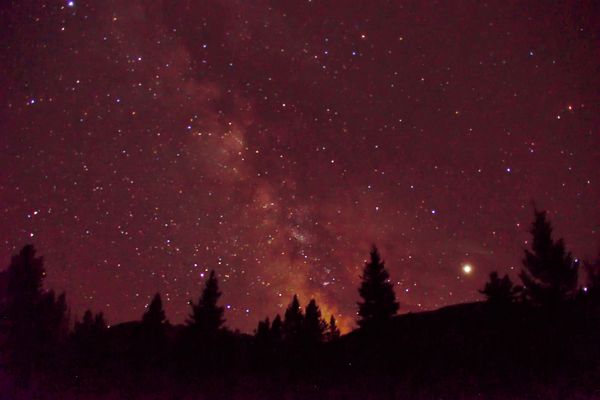Red/purple glow
Aug 1, 2019 14:11:25 #
Aug 1, 2019 14:19:22 #
Aug 1, 2019 14:33:08 #
daledo wrote:
What causes the red/purple glow in this long exposure milky way photo.
Looks to a white balance issue! Maybe try to adjust in post production do you use a software program.
Aug 1, 2019 14:35:00 #
Aug 1, 2019 21:32:21 #
Ray Maines wrote:
Inappropriate White Balance setting is my guess.
White balance settings on astrophotography shots are a matter of taste more than a matter of accuracy.
Andy
Aug 2, 2019 06:11:22 #
The recommendation of some very good professional night photographers I know is to dial in a kelvin temperature of 3850 for Milky Way... but yes, it is a matter of preference!
Aug 2, 2019 07:22:50 #
Probably white balance, but it really depends on where the photo was taken. If it's in high latitudes, it could be a red aurora. Red aurora will occur down to around 45 degrees latitude, but that's quite rare. Mostly you will see them above 55-60 degrees latitude.
Aug 2, 2019 08:34:16 #
Aug 2, 2019 09:28:20 #
cytafex
Loc: Clarksburg MA
Same reason color in sunsets, light being absorbed in upper atmosphere with long waves passing through. Later in the night color becomes more neutral.
Aug 2, 2019 09:55:36 #
Aug 2, 2019 10:01:11 #
Aug 2, 2019 10:28:34 #
FredCM wrote:
Any sodium streetlights that way?
no. its looking south into wilderness country.
Aug 2, 2019 12:52:51 #
daledo wrote:
What causes the red/purple glow in this long exposure milky way photo.
What time of night was this? If it was early, the higher part of the atmosphere was still being illuminated by the sun. Later when the sun is shining on the backside of the earth there will be less visibility of illumination of the surrounding blanket of atmosphere, although there will always be a little bit of that light reflected back to earth. You will always see the night sky just a tad brighter near the horizon.
Aug 2, 2019 15:12:27 #
CatMarley wrote:
What time of night was this? If it was early, the higher part of the atmosphere was still being illuminated by the sun. Later when the sun is shining on the backside of the earth there will be less visibility of illumination of the surrounding blanket of atmosphere, although there will always be a little bit of that light reflected back to earth. You will always see the night sky just a tad brighter near the horizon.
It was around midnight.
Aug 2, 2019 16:08:38 #
larryepage
Loc: North Texas area
Your photograph has captured just the northern portion of the "galactic core" at the horizon, and the orientation tells me that the photograph was taken somewhere pretty far north, perhaps close to your home in Montana. Any celestial object, when near the horizon, will appear redder than when it is higher in the sky, just like the moon and sun do when they are low in the sky. That is mostly what has happened here. The other thing that goes on with Milky Way photography is that because MW season in the Northern Hemisphere is in the Spring and Summer, the ground and lower atmosphere remain very warm long after the sun has set. The energy of that warmth is what creates the glow near the horizon that is prevalent in almost all Milky Way photographs, not just random noise as many folks think.
As to the proper color temperature for night sky photography, it all depends. At the last workshop I attended, our instructor insisted on 4,000K. To my eyes, that produced a sky that was just too uniform, blue, and uninteresting. If you do some research, you will learn that the galaxy consists of a pretty equal mix of giant stars with a red spectrum (say 2800K or so), white "main sequence stars like our sun (5800-6000K), and blue dwarfs (and other blue stars) with a color temperature of 8000K or even hotter. I generally set up for daylight white balance or else a custom white balance somewhere around 5800-6000K or so. That produces a pleasing overall appearance centered around white, but also will allow some nice variation in star colors upon close examination.
The truth is that our night vision is pretty variable from person to person (and sometimes even from day to day), so you may want to just adjust for what looks nice to you. Moving the white balance to a lower temperature does have the advantage of making the camera less sensitive to the horizon glow, but in my experience it will also reduce the intensity of the glow from the galactic core.
Another big consideration for these photographs is noise. Long exposures with digital cameras commonly introduce noise into images just due to the behavior of the sensor in the camera. For single image exposures (which this looks like), it is very important to make sure that both Long Exposure and High ISO noise reduction be used. The long exposure NR takes an exposure of with the shutter closed of the same length as your actual exposure, compares the two, then deletes the signal from any noisy pixels that are identified. Much better than doing so in post production. This is not as feasible when doing panoramas, because it increases the time, therefore capturing more movement due to the earth's rotation, and can sometimes introduce problem when stitching the panoramic image together.
Night sky photography is not an automatic win. It's pretty easy to get good initial images, but a lot of finesse is required to get those really outstanding ones. And these are most impressive when printed pretty large. Mine over the couch is about 19" x 45". To print that large will require quite a bit of care with your exposure. Best wishes as you move forward with this and continually more about it. It's fun in itself, and your family and friends will not be willing to accept that you were even able to do it.
As to the proper color temperature for night sky photography, it all depends. At the last workshop I attended, our instructor insisted on 4,000K. To my eyes, that produced a sky that was just too uniform, blue, and uninteresting. If you do some research, you will learn that the galaxy consists of a pretty equal mix of giant stars with a red spectrum (say 2800K or so), white "main sequence stars like our sun (5800-6000K), and blue dwarfs (and other blue stars) with a color temperature of 8000K or even hotter. I generally set up for daylight white balance or else a custom white balance somewhere around 5800-6000K or so. That produces a pleasing overall appearance centered around white, but also will allow some nice variation in star colors upon close examination.
The truth is that our night vision is pretty variable from person to person (and sometimes even from day to day), so you may want to just adjust for what looks nice to you. Moving the white balance to a lower temperature does have the advantage of making the camera less sensitive to the horizon glow, but in my experience it will also reduce the intensity of the glow from the galactic core.
Another big consideration for these photographs is noise. Long exposures with digital cameras commonly introduce noise into images just due to the behavior of the sensor in the camera. For single image exposures (which this looks like), it is very important to make sure that both Long Exposure and High ISO noise reduction be used. The long exposure NR takes an exposure of with the shutter closed of the same length as your actual exposure, compares the two, then deletes the signal from any noisy pixels that are identified. Much better than doing so in post production. This is not as feasible when doing panoramas, because it increases the time, therefore capturing more movement due to the earth's rotation, and can sometimes introduce problem when stitching the panoramic image together.
Night sky photography is not an automatic win. It's pretty easy to get good initial images, but a lot of finesse is required to get those really outstanding ones. And these are most impressive when printed pretty large. Mine over the couch is about 19" x 45". To print that large will require quite a bit of care with your exposure. Best wishes as you move forward with this and continually more about it. It's fun in itself, and your family and friends will not be willing to accept that you were even able to do it.
If you want to reply, then register here. Registration is free and your account is created instantly, so you can post right away.






